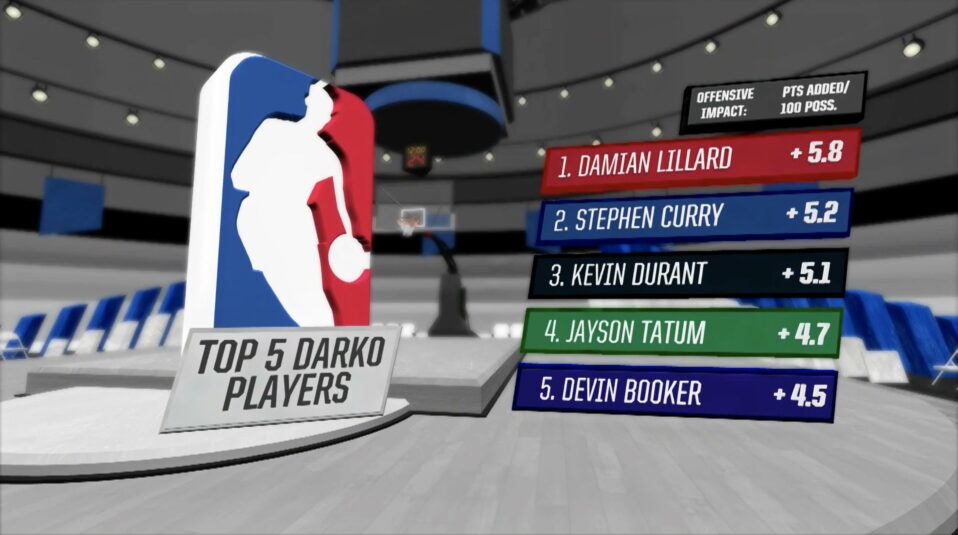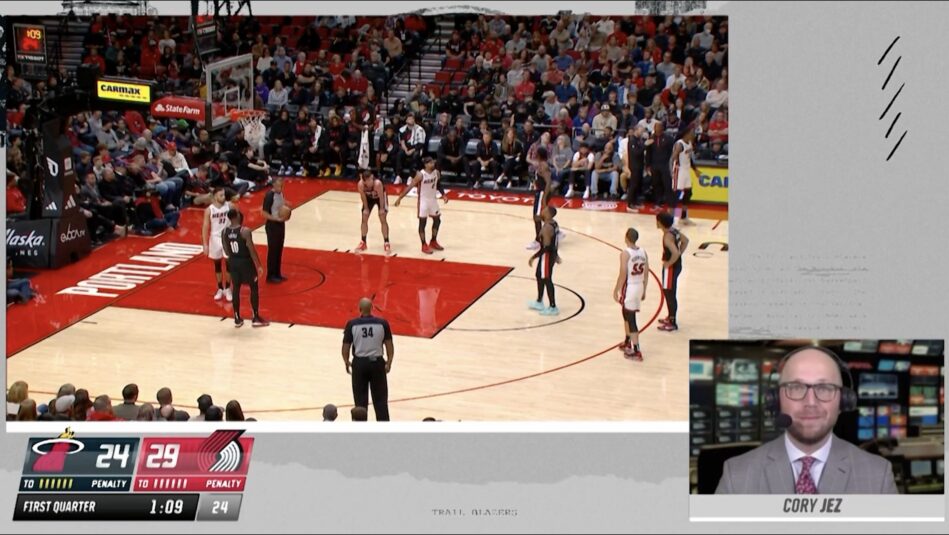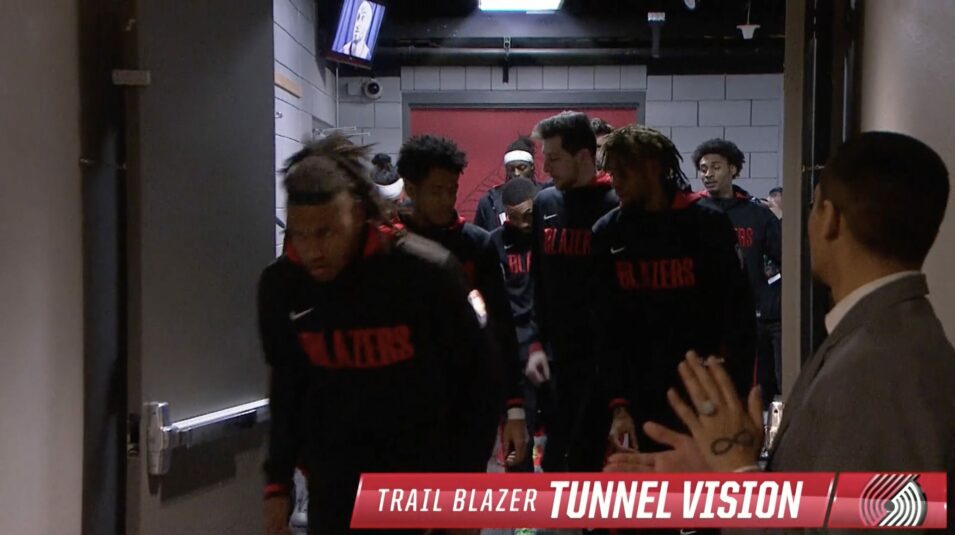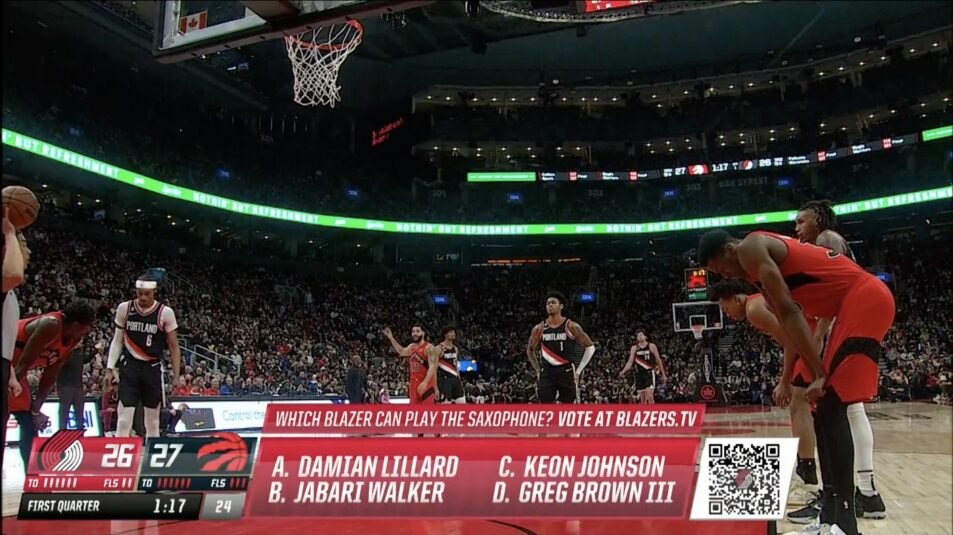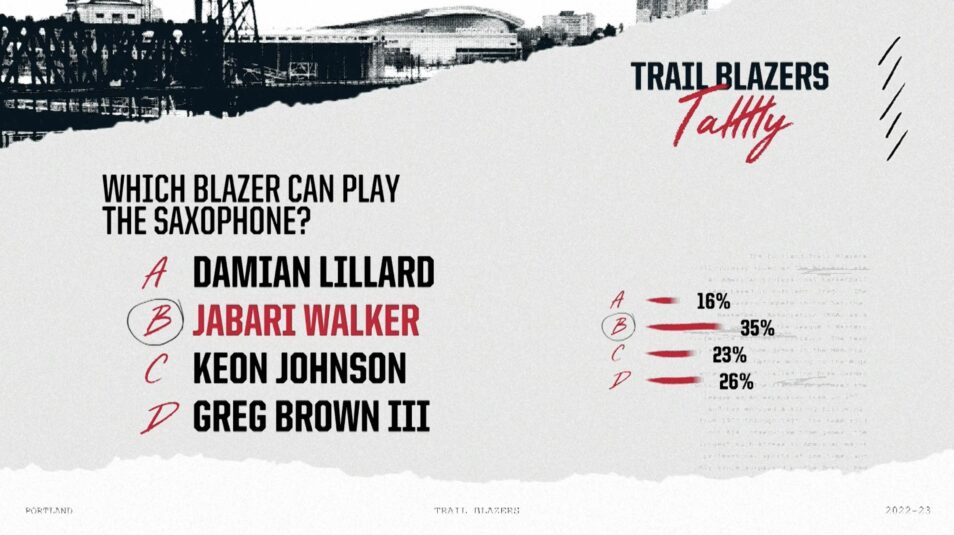Portland Trail Blazers Crank Up In-House Live Broadcasts With AR Graphics, Advanced Stats, New Camera Angles, Increased Fan Engagement
Four pillars — Elevate, Inform, Access, Engage — form the foundation of the enhancements
Story Highlights
In the sports-video–production industry, the Portland Trail Blazers are known as one of the more forward-thinking franchises in the National Basketball Association. One of only five teams in the league that produce all live broadcasts in-house, the club is taking it up a notch with next-gen broadcasts featuring advanced analytics, real-time AR graphics, increased access to players and staff via in-game audio and behind-the-scenes camera POVs, and increased fan integration with social media.
“Our fans love to talk about the Trail Blazers,” says Jeff Curtin, director, broadcasting, Portland Trail Blazers, “so we’re focusing on the stories of our team and giving access that viewers want to see. Our ownership is very happy with the elements that we’ve done, and the reaction from our fanbase has been positive.”
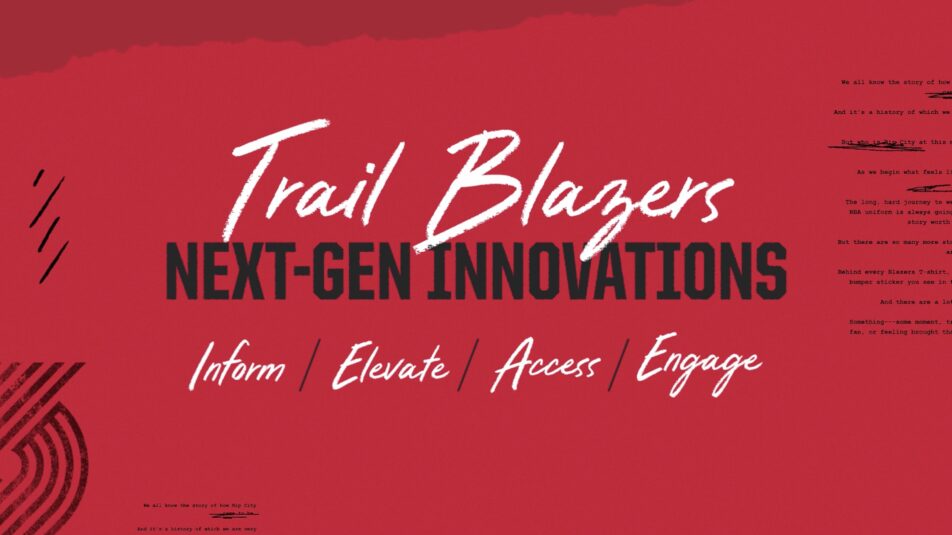
The Portland Trail Blazers’ next-gen broadcasts are focused on four main goals: Inform, Elevate, Access, and Engage.
Inform, Elevate, Access, Engage: Organization Focuses on Four Main Building Blocks
Not a team to rest on previous success — the franchise won the Northwest Regional Emmy for Best Sports Program, Live Event, or Game in 2019 — the production department worked with executives during the offseason to find ways of improving its broadcasts. With next-gen innovations and technologies making a splash at a national and regional level, the team aimed to replicate that energy and intensity for their games. For a massive endeavor, the club needed to move with a unified mission statement, and that’s where the four key goals of the initiative were established: Elevate, Inform, Access, Engage.
“These four pillars came from meetings that happened last spring,” says Curtin. “We wanted to map out and brainstorm what these next-generation broadcasts would look like.”
Discussions covered every possible detail, including the array of content that would be covered throughout the season and what new technological workflows could be added. Focusing on the fans, the four-pronged plan is intended to provide unparalleled exposure of their favorite team in ways that they’ve never experienced before. The fact that these games are produced in-house may seem daunting, but Curtin and his crew see it as a chance to have more freedom for creativity.
“Being able to control our own broadcast gives us so much more flexibility,” he says. “The flip side is that there’s a little bit more work that has to get done, but my team is passionate about their work. A network or a regional sports network could help us with that, but I look at our situation as an advantage.”
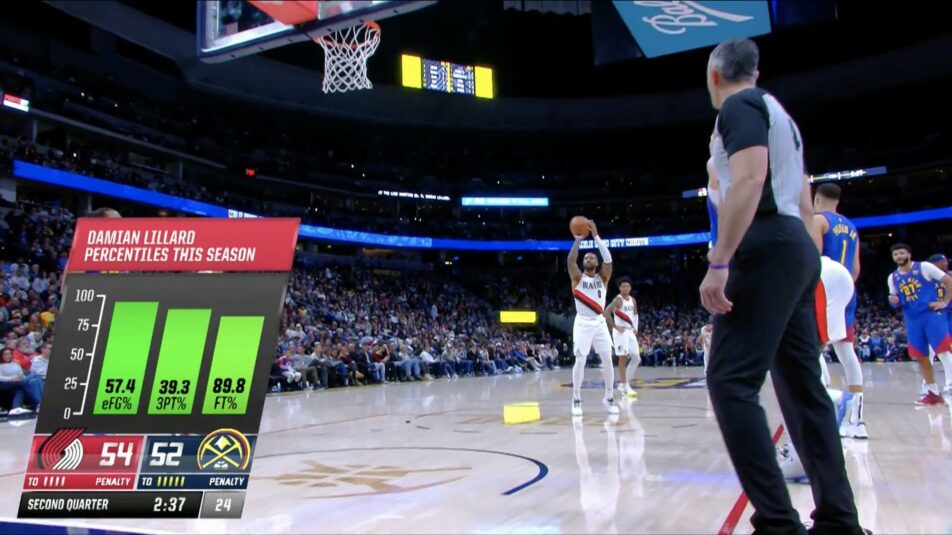
Second Spectrum provides real-time information for data-driven graphics like this percentiles chart.
A Delicate Balance: Mixing Advanced Metrics and Old-School Statistics
Basketball fans in the Pacific Northwest are familiar with traditional stats like points, rebounds, assists, and turnovers, but, deploying the more modern analytics approach that is taking the NBA by storm, Trail Blazers broadcasts showcase the new way of thinking in an entertaining way. Through a partnership with Second Spectrum and spearheaded by Trail Blazers Graphics Coordinator John McConnell, real-time player data and information are fed into the aesthetically pleasing graphics that the crew is developing with Vizrt. Following the technical renovation, broadcasts offer dynamic percentile graphics through pie charts and graphs and up-to-the-minute numbers allowing fans to see where players on the team rank in advanced categories — such as DARKO (Daily Adjusted and Regressed Kalman Optimized), a predictive metric that uses box score and plus-minus statistics.
“Second Spectrum has been a great partner,” says Curtin. “We’ve gotten these overlays for the first replay after a play happens, so the latency is super low. They’re also able to provide access to clips that are archived on their website, [enabling] our producers to quickly create playlists and let our announcers look at stats for research that they share during each game.”
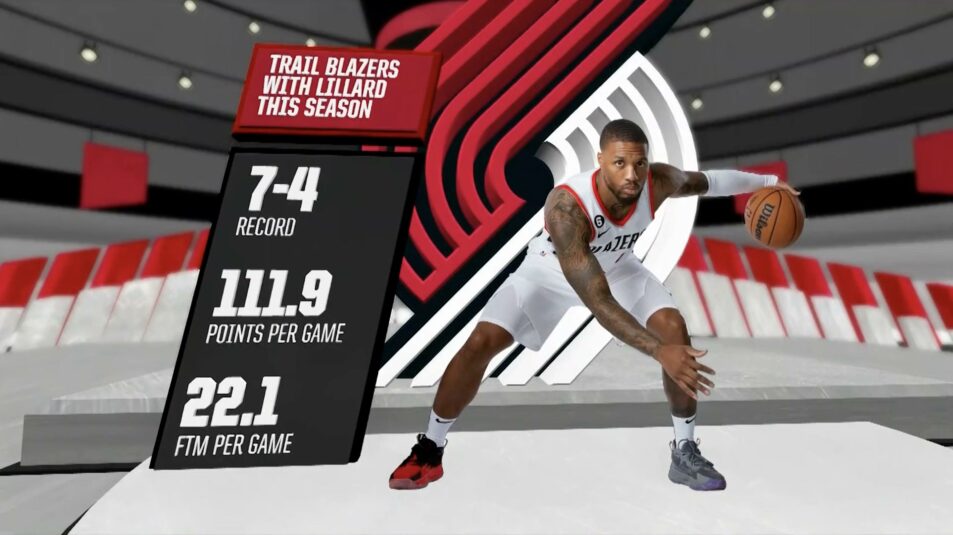
Augmented-reality graphics combine real-life photos of players within Vizrt-powered AR environments.
During pre/postgame and halftime shows, on-air graphics are ratcheted up to include traditional and advanced information in an augmented-reality (AR) environment. These elements are accompanied by real-life photos of the players and live interview footage. This is done through solutions provided by Vizrt and photographs captured during Trail Blazers Media Day and action shots during the game. With the goal to highlight all this material as much as possible, creating the right cocktail of traditional and new-age is one of the hardest parts of Curtin’s job.
“Finding that sweet spot of advanced stats and traditional stats has been a challenge for us,” he says. “We leaned a bit too much into percentile and advanced stats earlier in the season, but now we have that balance of showing a traditional box score along with advanced metrics sliding up from our scorebug.”
Guiding Voice: Analyst Cory Jez Meshes New-Age Discussions With Basic Telestration
To avoid confusing fans with unfamiliar stats, the “Inform” pillar of the plan was necessary to bridging the gap between younger and older demographics. Working alongside a loaded cast of talent on the studio side — hosts Jamie Hudson and Neil Everett, analysts Michael Holton and Francis Williams — and the broadcast side — play-by-play announcer Kevin Calabro, analyst Lamar Hurd, courtside reporter Brooke Olzendam — analytics insider Cory Jez has become the voice of the advanced-metrics fan in his first season with the team. Jez’s background comprises multiple stops with NBA teams and other professional clubs: analytics consultant with the Washington Wizards in 2021-22; director, sports science and analytics, with Austin FC in 2020; and director, basketball analytics, with the Utah Jazz in 2017.
“The addition of Cory has brought a deeper dive into the advanced stats that surround the game,” adds Curtin, “and he has been fantastic to work with. We’re using technology that we learned from the pandemic to bring him in remotely from his home in Texas.”
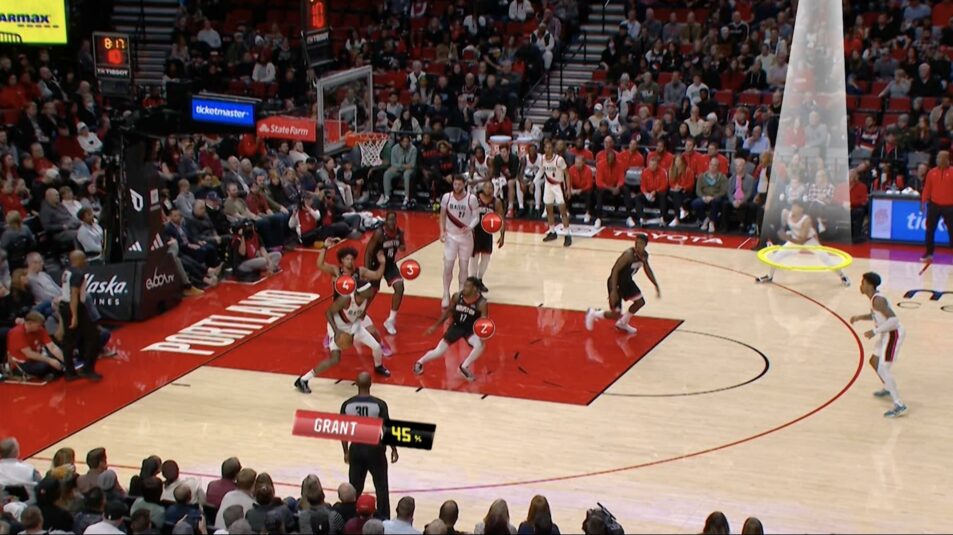
Traditional telestration is mixed with graphics showing a player’s shooting percentage from certain areas of the court.
With Jez controlling the explanation of advanced metrics, Curtin, producer Dan Hyatt, and the rest of the production team provide traditional tools to on-air talent. Both in the game and in the studio, analysts break down plays via FingerWorks Telestration and show players’ shooting percentages from any area of the floor with statistical graphics.
“Our analysts enjoy explaining plays and where players should and shouldn’t be,” says Curtin. “It’s hard to see elements like a pick-and-roll with a traditional camera angle, but, when you add overlays, arrows, and spot shadows, we feel that our fans understand the action better.”
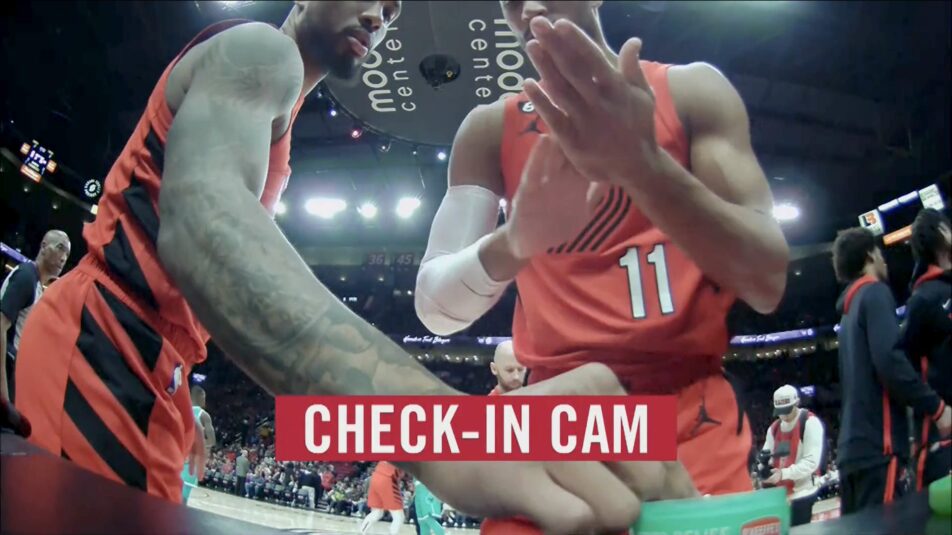
Check-In Cam, a Marshall POV camera positioned on the scorers table, was installed in the offseason.
On-Court Access: Miked Players, Enhanced Camera POVs Bring Fans Closer to the Hardwood
In a more cinematic sense, broadcasting and production place the fan at the heart of the action with new equipment and ideas. Technologically speaking, views from Check-In Cam and Tunnel Cam capture what it’s like to be next to the scorers table and running through the players entrance to the court within Moda Center. To make every broadcast feel like a big show, the newly installed Marshall POV camera is augmented with POVs placed above the stanchion of the hoops, behind the basket, and in other areas.
Increased player access also means miking various coaches and players every game. To spotlight off-the-cuff interactions and unique relationships, Curtin and his team leverage an NBA-approved wireless microphone system as well as a bond forged with the internal public relations team, head coach Chauncey Billups, and the players.
“We’ve done this so often that we’ll do everyone on the team once and other people twice,” notes Curtin. “Chauncey loved the idea, so we started with him first and have worked our way through the roster. After Damian [Lillard] passed the franchise scoring record, that was the first time he has worn a microphone in a live regular-season game.”
Fan Interaction: Improved Trivia Questions, QR Codes Integrate Viewers Into the Broadcast
In addition, Trail Blazers fans are a vital part of game broadcasts via the folding-in of social media. In previous seasons, Olzendam would reference a handful of tweets that she would see on Twitter, but, with new interactive graphics, a new strategy was created with the marketing, sponsorship, and digital teams.
“When a player gets hot and there’s a lot of activity on social media,” says Curtin, “we’re able to pop in fans’ tweets and reactions. Through Vizrt and our graphics team, our system is close to getting these elements out in real time.”
Fans are also involved via trivia quizzes on team history and current players. QR codes, which have continued to gain traction since COVID-19, enable fans to participate in the quizzes and access the team’s website.
“Our producers and our production assistant come up with timely poll questions,” adds Curtin. “We’re able to change [the questions] in-game if something happens. Overall, our sales team and marketing team found these QR codes to be effective, and we’ve now found value for them on the broadcast.”
Impact on the League: Trail Blazers Forge Ahead With League-Wide Recognition
Curtin sees his crew as hitting its stride, with fewer than 20 games left in the 2022-23 regular season. “It was a huge lift for my team with a ‘crawl, walk, run,’ but I think our productions have looked really good. We’re now refining [these broadcasts] during the last third of the season.”
Around the NBA, other teams are starting to take notice of the Trail Blazers’ hard work over the past several months.
“My team gets a lot of satisfaction when our peers say positive things to us in places like the media room and loading dock,” says Curtin.
Internally, the enhancements required the coordination of many people. As time goes on, more organizational buy-in can lead to other avenues for broadcast development.
“I’m super proud of my team and what we’ve accomplished,” he says. “Since everyone supports the concept and ideas, it has become super successful.”
Of the remaining 16 games on the schedule, nine will be played at Moda Center: vs. New York on March 14, vs. Boston on March 17, vs. Los Angeles Clippers on March 19, vs. Chicago on March 24, vs. Oklahoma City on March 26, vs. New Orleans on March 27, vs. Sacramento on March 29 and March 31, and vs. Golden State on April 9.
